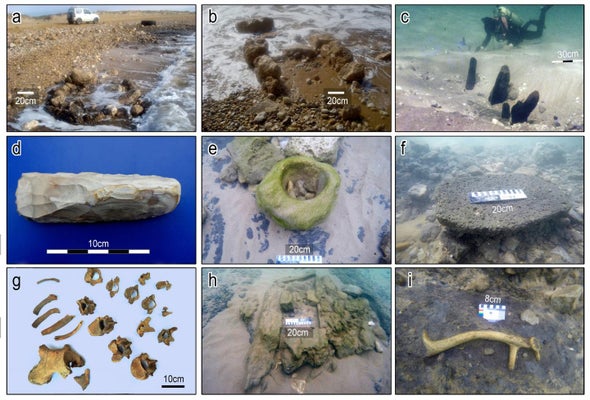(单词翻译:单击)
听力文本
This is Scientific American's 60-second Science, I'm Christopher Intagliata.
Go snorkeling in a lot of places, you'll find coral. But on Israel's Mediterranean coast?
"I think it's the only place in the world that you can find whole prehistoric villages submerged under the sea."
Ehud Galili is an underwater archaeologist at the University of Haifa. He says one submerged village, called Tel Hreiz, sits 5 to 10 feet under the water. The community was populated some 7,000 years ago.
There, the archaeologists have found pottery and flint, human skeletons, the remains of deer, cows, pigs and dogs, and hundreds of olive pits—probably the remains of olive oil production. And the researchers also found a 300-foot long stretch of huge boulders—a wall.
After ruling out other possible uses for the wall—like defense against enemies or corralling animals—the scientists determined that the formation was actually an ancient seawall, the oldest known example in the world. The results are in the journal PLOS ONE.

The boulders that kept the waters of the Mediterranean from flooding the village came from riverbeds a mile or two away. And the researchers say that it would have taken multiple people—or strong beasts of burden—to move them into place, suggesting that constructing the wall was a well-organized community effort. But eventually, the sea beat the barrier.
"Little by little, sea level continued to rise, and then it became no more effective. At some point, the cost of continuing to struggle with the sea was too high economically, and they made a decision to abandon the village."
Of course, our technology is far more advanced than what they had seven millennia ago. But this sunken seawall is still a warning of what can happen when humans battle rising seas.
Thanks for listening for Scientific American's 60-second Science. I'm Christopher Intagliata.
参考译文
这里是科学美国人——60秒科学系列,我是克里斯托弗·因塔格里塔。
如果你经常去潜水,你会发现很多地方都有珊瑚。但以色列的地中海沿岸有吗?
“我认为这是世界上唯一一处可以发现沉入海底的整个史前村庄的地方。”
海法大学的水下考古学家埃胡德·加利利说到。他表示,一个叫作“泰尔赫雷兹”的水下村庄坐落在距离海面5到10英尺处。这个村庄大约在7000年前开始有人居住。
考古学家在那里发现了陶器和燧石、人类骨骼、鹿、牛、猪和狗的遗骸,还有数百个橄榄坑,这可能是橄榄油生产地遗址。研究人员还发现了一段300英尺长的巨石墙。
在排除了这座墙用于防御敌人或圈养动物等其他可能用途后,科学家判定该结构实际上是古代防波堤,是全世界已知最古老的范例。研究结果发表在《公共科学图书馆·综合》期刊上。
阻止地中海海水淹没村庄的卵石来自一两英里外的河床。研究人员表示,需要众多人力或强壮的兽类才能将那些巨石运过来,这表明建造那座墙是组织有序的群体行动。但最终,大海还是淹没了这座防波堤。
”海平面一点一点地不断上升,然后防波堤便不再起作用。在某种程度上,持续与大海抗争的经济成本过高,所以他们决定放弃这座村庄。”
当然,现在我们的技术比7000年前要先进得多。但这座沉没的防波堤依然提醒我们,人类与不断上升的海平面对抗时会发生什么。
谢谢大家收听科学美国人——60秒科学。我是克里斯托弗·因塔利亚塔。
译文为可可英语翻译,未经授权请勿转载!
重点讲解
重点讲解:
1. rule out 排除;不予考虑;
Local detectives have ruled out foul play.
当地的侦探已经排除了他杀的可能性。
2. come from 来自;
Help may also come from some unexpected places.
帮助也可能来自某些意想不到的地方。
3. little by little 逐渐地;一点一点地;
I would have to learn, little by little, to exist alone.
我得慢慢学会独自生活。


